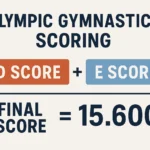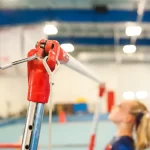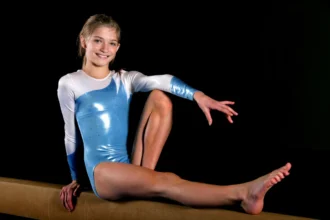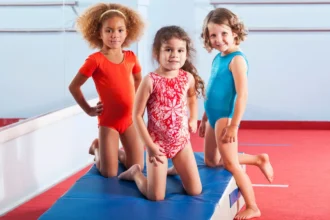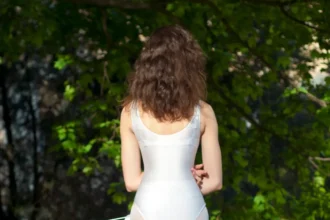Gymnastics requires precise movements, strength, and grace. But beyond the impressive skills and sparkling leotards, gymnasts sometimes face awkward and disruptive challenges, like wardrobe malfunctions. These mishaps can be embarrassing and even impact scoring. Yet, are they just accidents, or are they inevitable due to the nature of the sport?
What Is a Gymnastics Wardrobe Malfunction?
A gymnastics wardrobe malfunction is when a gymnast’s outfit doesn’t stay in place as it should. This could mean their leotard slips, rips, or shows more skin than they meant during a routine. It happens because flips, twists, and fast moves can pull or stretch the fabric in unexpected ways.
Examples of gymnastics wardrobe malfunctions include:
- A shoulder strap falling down
- The leotard riding up into a wedgie
- A tear or rip in the fabric
- Zippers or clasps coming undone
- Undergarments showing or the leotard becoming see-through under bright lights
This can be embarrassing or distracting, but it’s usually just an accident from all the high-energy action.
What Happens If There’s a Wardrobe Malfunction?
In gymnastics, wardrobe malfunctions don’t automatically lead to deductions, but they can affect a gymnast’s score depending on how the situation unfolds.
In most cases, judges will not penalize the gymnast unless:
- The athlete adjusts the garment mid-routine (e.g., tugging a wedgie, fixing a strap).
- The wardrobe issue causes a disruption or pause in the performance.
- The malfunction leads to a violation of attire rules (e.g., exposure, missing elements like required sleeves or logos).
Olympic champion Nastia Liukin once reminded fans that fixing a wedgie, even for a split second, can cost tenths of a point, so most gymnasts simply push through the discomfort to avoid deductions.
| Organization | Violation Example | Deduction Type | Amount |
|---|---|---|---|
| FIG (2025–28) | Jewelry, bandages, illegal leo design | Neutral deduction | 0.10 |
| USAG Development Program | Backless leo, visible underwear, narrow straps | One-time neutral | 0.20 |
| NCAA Women’s Gymnastics | Out of uniform (e.g., exposed bra strap) | Team neutral | 0.30 |
| All Levels | Fixing clothing during routine | Execution deduction | ~0.10 |
Source: gymnastics.sport, NCAA gymnastics
High-Profile Wardrobe Malfunctions in Gymnastics
In 2017, British gymnast Rob Payne experienced a wardrobe malfunction during his rings routine. A part of his attire detached in the middle of the performance, resulting in a deduction from his score. Despite this setback, Payne kept his composure and finished the routine, showing resilience and professionalism under pressure.
In 2019, an online discussion on Reddit drew attention to a surprising number of wardrobe malfunctions at a national gymnastics competition. Some athletes had issues with their underwear becoming visible during routines, leading to deductions. This highlighted the importance of proper attire fit and the need for athletes to be prepared for any wardrobe challenges that may arise during their performances.
In response to concerns about comfort and the sexualization of the sport, German female gymnasts chose to wear full-body suits, or unitards, during the 2024 Paris Olympics. These suits offered more coverage and comfort, allowing athletes to focus entirely on their performances without the distraction.
It’s clear that the right clothing plays a big role in a gymnast’s performance and focus, and the sport is continuing to adapt to better meet athletes’ needs.
How to Handle a Wardrobe Malfunction During a Routine?
Despite the best efforts to prevent them, wardrobe malfunctions can still occur during a routine. When they do, it’s important to stay calm and composed.
Gymnasts should focus on continuing their performance and, if necessary, make discreet adjustments when possible. The key is not to let the malfunction disrupt the routine flow or detract from the performance.
In some cases, if a malfunction is severe and can’t be quickly fixed, a gymnast may need to pause their routine and ask for a brief moment to adjust. Judges are generally understanding of such situations, especially if the malfunction is beyond the gymnast’s control.
Can Wardrobe Malfunctions Be Prevented?
Wardrobe malfunctions may seem unpredictable, but many are avoidable with the right preparation and attention to detail. Coaches and athletes work hard behind the scenes to reduce the risk. Here’s how:
1. Choose the Right Fit
A well-fitted leotard is crucial. It should be snug without being too tight, and designed to stay in place during high-level movement. Since gymnasts have different body types, many elite athletes wear custom-made leotards tailored for their specific build.
For instance, Simone Biles has a compact, muscular frame, while Aly Raisman is taller with a different physique. Their uniforms are custom-fitted to help them move freely and perform confidently without distractions.
2. Practice in Full Competition Gear
Many wardrobe issues don’t show up until gymnasts perform their full routines. That’s why practicing in the exact leotard (or singlet and shorts) intended for competition, along with the same undergarments, is a must. This helps spot any sliding straps, riding fabric, or uncomfortable seams before meet day.
3. Use Body Adhesives
To keep leotards in place, gymnasts often apply:
- Butt glue or fashion tape to prevent wedgies
- Hairspray or grip spray around the hips or back
- Toupee or body tape under shoulder straps or chest panels
These are safe, discreet, and widely used—even at the elite level.
4. Reinforce Weak Points
Thin straps, zippers, or decorative seams can fail under stress. Coaches often reinforce these areas with stitching or clear thread to prevent mid-routine tears or shifting.
5. Pick Seamless or Skin-Tone Undergarments
Visible underwear is a frequent cause of deductions. Many gymnasts wear flesh-colored, seamless briefs—or go without—to avoid visible lines. Specialized athletic undergarments are also a popular choice.
6. Avoid Unapproved Designs
While stylish, some leotard designs (like sheer panels or deep V-cuts) may not meet competition rules. Choosing designs approved by FIG or USAG helps avoid last-minute dress code violations.
7. Test in Lighting Conditions
Stage lights can reveal more than expected. Testing leotards under bright lighting ensures there are no transparency issues once gymnasts are on the floor.
8. Double-Check Before Taking the Floor
Just before the competition, coaches often do a final visual check for:
- Slipping straps
- Loose zippers or clasps
- Rolling waistbands or visible seams
In a word, the more a gymnast can do to ensure their gear fits securely, the less likely a mishap will affect their performance.

